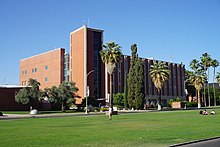Gerard Kuiper
Gerard Kuiper | |
|---|---|
selenographer | |
| Known for | Kuiper belt |
| Spouse |
Sarah Fuller (m. 1936) |
| Scientific career | |
| Fields | Astronomy |
| Thesis | Statistische onderzoekingen van dubbelsterren (1933) |
| Doctoral students | Carl Sagan |
Gerard Peter Kuiper (
Kuiper is considered by many to be the father of modern planetary science.[1]
Early life and education
Kuiper, the son of a tailor in the village of Tuitjenhorn in North Holland, had an early interest in astronomy. He had extraordinarily sharp eyesight, allowing him to see with the naked eye magnitude 7.5 stars, about four times fainter than those visible to normal eyes.
He studied at
Kuiper received his PhD degree from Leiden University in the Netherlands on his thesis on binary stars with Hertzsprung in 1933.
Career
He traveled to California to become a fellow under Robert Grant Aitken at the Lick Observatory. In 1935 he left to work at the Harvard College Observatory, where he met Sarah Parker Fuller (1913-2000), whom he married on 20 June 1936. Although he had planned to move to Java to work at the Bosscha Observatory, he took a position at Yerkes Observatory of the University of Chicago and received American citizenship in 1937.
During the second world war, from 1943 to 1945 Kuiper took leave of absence from the University of Chicago to research radar countermeasures at the faculty of Harvard's Radio Research Laboratory. This led to attachment to the Eighth Air Force Headquarters, England (1944) and return to Europe (January 1945, seconded to the ALSOS mission). Besides assessing the state of German science, Kuiper accomplished a rather daring rescue of Max Planck, stuck in the eastern zone of Germany and in danger of being captured by the Soviets. Kuiper raced across the countryside only hours ahead of the Soviets to retrieve Planck and his wife.
From 1947 to 1949, Kuiper served as the director of the McDonald Observatory in west Texas.[2] In 1949, Kuiper initiated the Yerkes–McDonald asteroid survey (1950–1952).
From 1950-1960 he was professor at the University of Chicago, directing the Yerkes Observatory. He was doctoral advisor to Carl Sagan. In 1958, the two worked on the classified military Project A119, a secret Air Force plan to detonate a nuclear warhead on the moon.[3] In 1959, he sent Jürgen Stock (astronomer) to Chile, to search for suitable sites of an observatory for the Southern skies, who eventually would identify the spot for the Cerro Tololo Inter-American Observatory.[4]
In 1960 Kuiper moved to
, serving as the laboratory's director for the rest of his life, until his death in 1973.Discoveries
Kuiper discovered two
In the 1950s Kuiper's interdisciplinary collaboration with the geochemist and Nobel Laureate
In the 1960s, Kuiper helped identify landing sites on the Moon for the Apollo program.[a]
Kuiper discovered several binary stars which received "Kuiper numbers" to identify them, such as KUI 79.
Personal life and death
He married Sarah Parker Fuller (1913-2000) on 20 June 1936. Kuiper died age 68 of a heart attack on 23 December 1973 in Mexico City, while on vacation with his wife.[7]
Honors

- In 1947, Kuiper was awarded the Prix Jules Janssen of the Société astronomique de France (Astronomical Society of France).
- In 1959, Kuiper won the Henry Norris Russell Lectureship of the American Astronomical Society.
- In 1971, Kuiper received the Kepler Gold Medal from the American Association for the Advancement of Science and the Franklin Institute.
Besides the
Astronomers refer to a region of minor planets beyond Neptune as the "Kuiper belt", since Kuiper had suggested that such small planets or comets may have formed there. However Kuiper himself believed that such objects would have been swept clear by planetary gravitational perturbations, so that none or few would exist there today.[citation needed]
The
One of the three buildings at Arizona that makes up the Lunar and Planetary Laboratory is named in his honor.[8]
In popular culture
Episode 6 ("The Man of a Trillion Worlds") of the TV series Cosmos: Possible Worlds featured the Kuiper–Urey conflict.[citation needed]
Notes
- ^ Cameras in Ranger VIII were turned on 23 minutes before impact, and the spacecraft transmitted pictures back to earth until it struck the surface and was destroyed. The flight's product would be intensively studied by a panel of noted lunar scientists, among them Gerard P. Kuiper and Ewen A. Whitaker of the University of Arizona and Harold C. Urey of the University of California. — Brooks & Ertel (1976, p. 75)[6]
- Eugene Shoemaker.
References
- ^ "NASA Solar System Exploration". solarsystem.nasa.gov. National Aeronautics and Space Administration (NASA). Archived from the original on 11 April 2015. Retrieved 12 April 2015.
- ^ "Milestones". McDonald Observatory. Retrieved 25 November 2020.
- ISBN 978-1-85233-746-9.
- ISSN 1626-0252.
- ISBN 9780521115681.
- ^ Brooks, Courtney G.; Ertel, Ivan D. (1976). The Apollo Spacecraft: A chronology. Scientific and Technical Information Division, Office of Technology Use. National Aeronautics and Space Administration (NASA). p. 75.
- ^ Williams, Matt (11 November 2015). "Who was Gerard Kuiper?". Universe Today. Retrieved 24 March 2020.
- ^ "A Brief History of LPL". University of Arizona. Retrieved 1 June 2024.
External links
 Media related to Gerard Kuiper at Wikimedia Commons
Media related to Gerard Kuiper at Wikimedia Commons- "Gerard Peter Kuiper: NASA KAO's namesake". Biography. National Aeronautics and Space Administration (NASA). Archived from the original on 13 July 2014.
- "Gerard Kuiper Papers". AzArchivesOnline.org. Archive. University of Arizona.
- Dale P. Cruikshank. "Gerard Peter Kuiper, 1905—1973" (PDF). Biographical Memoir. National Academy of Sciences.
